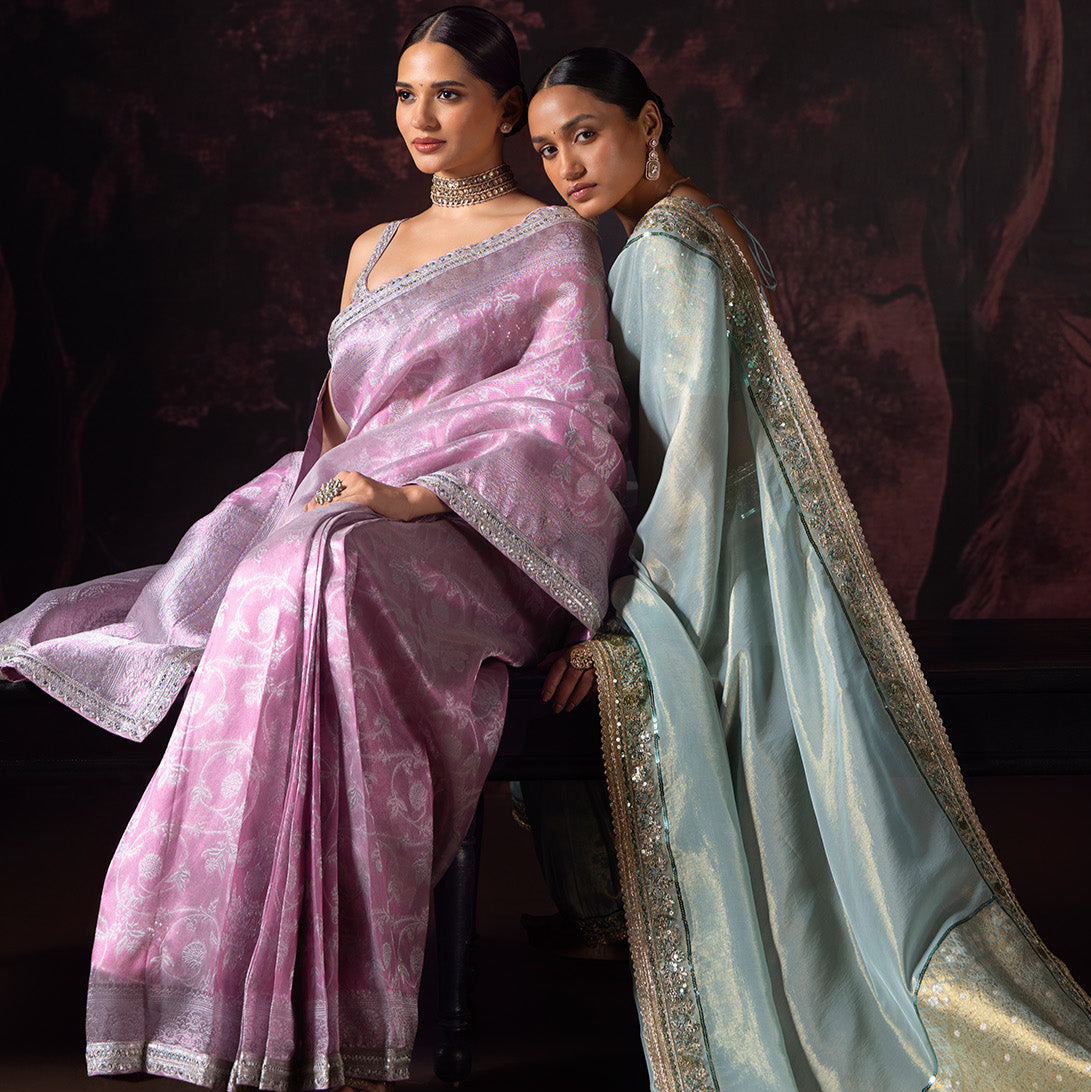
Embellishing Fabrics: Indian Styles We Love
Indian textiles are renowned for their intricate embellishments and craftsmanship. The art of embellishing fabrics in India has a long-standing tradition, and various styles have emerged over time. This time-honored tradition involves various techniques and styles. Embellishments add beauty, richness, and intricate details to fabrics, making them highly sought after.
The most popular style of embellishment on Indian textiles is embroidery. This widely used embellishment technique in Indian textiles involves stitching decorative patterns or motifs onto the fabric using threads of various colors. The more labor intensive the embroidery is such as hand-embroidery, the more expensive the final product becomes. Over time, we have moved from hand-work to machine work and there are many kinds of embroidery techniques today.
Different types of embroidery techniques are zari work (metallic thread embroidery), resham work (silk thread embroidery), mirror work, sequin work, and beadwork. Embroidery can be seen on sarees, salwar suits, lehengas, dupattas, and various traditional garments. Here are some Indian styles of fabric embellishment that are widely loved.
Enchanting Zari Work That Will Turn Heads
Zari zardozi is a famous embroidery technique that originated in Persia and was later embraced by Indian artisans. It involves intricate metal threadwork, often in gold or silver, embellishing fabrics like silk, velvet, or satin. Zardozi embroidery adds a luxurious and opulent touch to garments, making them perfect for special occasions and bridal wear.
Zari work has a long history in India and is believed to have originated during the Mughal era. It was initially crafted with real gold and silver threads, but over time, these precious metals were replaced with metallic threads made of copper, polyester, or silk coated with gold or silver.
Zari threads used in embroidery can vary in composition and appearance. Pure zari threads are made of fine gold or silver and are highly valued for their luster and shine. However, due to cost and availability, imitation zari threads made of copper or brass wires coated with gold or silver are commonly used in contemporary zari work.
Zari work is done by skilled artisans who use various techniques to create intricate patterns and motifs on fabric. Common patterns in zari work include floral designs, paisleys, geometric shapes, and intricate borders. These patterns are often combined with other embellishments like sequins, beads, and stones to enhance the overall effect.
The Gemstone Elegance of Stone Embellishments
Fabric embellishments with stones, such as rhinestones, crystals, and gemstones, are popular in Indian textiles. These stones are often hand-embroidered onto the fabric to create dazzling and eye-catching designs. Stone embellishments are commonly used in wedding and festive attire, providing a glamorous and elegant look.
Lashkaraa’s stone embellished picks? Our Periwinkle Embellished Crop Sharara Set brims with quintessential handcrafted ornaments makes this style effortlessly graceful. The sharara features a breath-taking amalgam of miniature and bold floral patterns of thread-work and ribbon handwork with hints of sequin. A matching dupatta with heavily worked detailing spread across one side of the border.
Unraveling the Magic of Thread Work and Hand Embroidery
Thread-work is a popular and intricate embellishment technique used on Indian textiles. It involves the use of threads of various colors and materials to create decorative patterns and designs on fabric. It adds depth, texture, and intricate details to fabrics, enhancing their overall aesthetic appeal. The choice of thread colors, stitch types, and designs can vary based on regional traditions, personal preferences, and the intended use of the fabric.
Lashkaraa’s favorite hand-embroidered picks are the Blush Pink Thread Embroidered Lehenga and the Dusty Mint Green Thread Embroidered Lehenga. Both the styles are perfect for semi-formal to formal functions which can be dressed up or down with the right accessories. Another statement-making ensemble would be the Golden Cream Thread Embroidered Lehenga that comes with a strapless cropped choli and a heavy thread embroidered lehenga. This sultry yet classy style is ideal for both day and night functions.
The Ancient Craft of Mirror Work
Mirror work, also known as shisha embroidery, is a testament to the rich cultural heritage and craftsmanship of Indian artisans. Prevalent in regions like Rajasthan and Gujarat, mirror work in Indian textiles adds a lively and distinctive element to fabrics, reflecting the vibrancy and celebratory spirit of Indian culture. This technique involves small pieces of mirrors that are incorporated into the fabric using colorful thread-work, creating a reflective and vibrant effect. Mirror work is often seen on traditional garments like cholis (blouses), dupattas (scarves), and lehengas (skirts).
Other embroidery styles include gota patti, chikankari, kantha, phulkari, Kashmiri, kasuti, aari and Parsi gara among other works. Lashkaraa’s latest occasion wear collections like ‘Hoor’ and ‘La Belle’ feature both heavily embellished and light versions. La Belle’s styles are both printed with embroidered elements to elevate the outfits. For heavily embroidered styles, Hoor’s Dusty Beige and Maroon Embroidered Lehenga, Dusty Purple Embroidered Sharara, Teal Green and Pink Embroidered Patiala Suit, are some of the styles one can wear to special occasions. These Indian ensembles can be a part of the bridal trousseau, the bride’s outfit or even her bridesmaids and the guests, depending on the occasion and how they are accessorized.
These are just a few of the many embellishment styles in Indian textiles. Each style has its own unique characteristics, reflecting the cultural heritage and artistry of different regions in India. These embellishments add charm, intricacy, and a touch of tradition to fabrics, making them highly coveted and loved by people all over the world.
Sources:
Veteran designer Ritu Kumar on the history and techniques of zardozi embroidery | Vogue India
Embroidery Techniques: The True Luxury of Indian Couture | Luxury Facts














